Tourism as a Key for Regional Revitalization?: A Quantitative Evaluation of Tourism Zone Development in Japan
Abstract
:1. Introduction
2. Background Study
2.1. Tourism Nation and Tourism Zone Development
2.1.1. Tourism Nation and Regional Revitalization
2.1.2. Target Policy: Tourism Zone Development
2.2. Tourism Policy Evaluation
2.2.1. Policy Evaluation Method
2.2.2. Tourism Policy Evaluation in Japan
3. Research Framework
3.1. Theoretical Background and Methodology
3.2. Data
- National urban traffic characteristic survey (person trip data)
- Regional data
3.3. Research Procedures
- Did the development of tourism zones have an impact? (Method: quasi-experiment)
- How will the effects vary across tourism zones? (Method: regression modeling)
4. Results
4.1. Data Processing
- Data cleaning
- Data matching
- Data adjusting
4.2. Policy Impact Measurement: Quasi-Experiment
4.2.1. Categorizing Tourism Zones
4.2.2. Exploratory Factor Analysis
4.2.3. Cluster Analysis
4.2.4. t-Test: Tourism Zone vs. Control Group
4.3. Policy Impact Measurement: Regression Modeling
4.3.1. Variable Setting
4.3.2. Regression Model for All Tourism Zones
4.3.3. Regression Model for Most vs. Least Effective Case
4.3.4. Regression Model for Each Category
4.3.5. Synthesis of Regression Models
4.4. Comprehensive Results
5. Discussion
6. Conclusions
Author Contributions
Funding
Institutional Review Board Statement
Informed Consent Statement
Data Availability Statement
Acknowledgments
Conflicts of Interest
Appendix A. List of Tourism Zones
| No. | Name | Constituent Cities/Towns |
| 1 | Furano Biei Wide Tourism Zone | Hokkaido Furano-shi, Biei-cho, Kamifurano-cho, Nakafurano-cho, Minamifurano-cho, Shimukappu-mura |
| 2 | Elegant Wide Tourism Zone | Iwate-ken Ichinoseki-shi, Oshu-shi, Hiraizumi-cho, Miyagi-ken Sendai-shi, Kesennuma-shi, Tome-shi, Osaki-shi, Matsushima-machi, Rifu-cho, Minamisanriku-cho, Yamagata-ken Mogami-machi |
| 3 | Aizu and Yonezawa Region Tourism Zone | Fukushima-ken Aizuwakamatsu-shi, Kitakata-shi, Shimogo-machi, Minamiaizu-machi, Kitashiobara-mura, Nishiaizu-machi, Bandai-machi, Inawashiro-machi |
| 4 | Tenderness and Natural Warmth Fukusima Tourism Zone | Fukushima-ken Fukushima-shi, Soma-shi, Nihonmatsu-shi, Date-shi |
| 5 | Mito Hitachi Tourism Zone; Your Sky and Earth | Ibaraki-ken Mito-shi, Hitachi-shi, Hitachiota-shi, Takahagi-shi, Kitaibaraki-shi, Kasama-shi, Hitachinaka-shi, Hitachiomiya-shi, Naka-shi, Oarai-machi, Shirosato-machi, Tokai-mura, Daigo-machi |
| 6 | Southern Boso Region Tourism Zone | Chiba-ken Tateyama-shi, Kamogawa-shi, Minamiboso-shi, Kyonan-machi |
| 7 | Mt. Fuji and Fuji Five Lakes Tourism Zone | Yamanashi-ken Fujiyoshida-shi, Nishikatsura-cho, Oshino-mura, Yamanakako-mura, Narusawa-mura, Fujikawaguchiko-machi |
| 8 | Ise Shima Region Tourism Zone | Mie-ken Ise-shi, Toba-shi, Shima-shi, Minamiise-cho |
| 9 | Kyoto Prefecture Tango Tourism Zone | Kyoto-fu Maizuru-shi, Miyazu-shi, Kyotango-shi, Ine-cho, Yosano-cho |
| 10 | Sanin Cultural Tourism Zone | Tottori-ken Yonago-shi, Kurayoshi-shi, Sakaiminato-shi, Misasa-cho, Yurihama-cho, Kotoura-cho, Hokuei-cho, Hiezu-son, Daisen-cho, Nambu-cho, Hoki-cho, Nichinan-cho, Hino-cho, Kofu-cho, Shimane-ken Matsue-shi, Izumo-shi, Oda-shi, Yasugi-shi, Unnan-shi, Okuizumo-cho, Iinan-cho, Ama-cho, Nishinoshima-cho, Chibu-mura, Okinoshima-cho |
| 11 | Hiroshima, Miyajima, and Iwakuni Region Tourism Zone | Hiroshima-ken Hiroshima-shi, Kure-shi, Otake-shi, Hatsukaichi-shi, Etajima-shi, Kaita-cho, Kumano-cho, Saka-cho, Yamaguchi-ken Iwakuni-shi, Yanai-shi, Suooshima-cho, Waki-cho |
| 12 | Nishi Awa Tourism Zone | Tokushima-ken Mima-shi, Miyoshi-shi, Tsurugi-cho, Higashimiyoshi-cho |
| 13 | New East Kyushu Tourism Zone | Oita-ken Oita-shi, Beppu-shi, Saiki-shi, Usuki-shi, Tsukumi-shi, Yufu-shi, Miyazaki-ken Nobeoka-shi |
| 14 | Aso Kuju Tourism Zone | Kumamoto-ken Aso-shi, Minamioguni-machi, Oguni-machi, Ubuyama-mura, Takamori-machi, Nishihara-mura, Minamiaso-mura, Yamato-cho, Oita-ken Taketa-shi, Miyazaki-ken Takachiho-cho |
| 15 | Shiretoko Tourism Zone | Hokkaido Shari-cho, Kiyosato-cho, Shibetsu-cho, Rausu-cho |
| 16 | Sapporo Wide Tourism Zone | Hokkaido Sapporo-shi, Ebetsu-shi, Chitose-shi, Eniwa-shi, Kitahiroshima-shi, Ishikari-shi, Tobetsu-cho, Shinshinotsu-mura |
| 17 | New Travel in Aomori, Lake Towada Wide Tourism Zone | Aomori-ken Aomori-shi, Hachinohe-shi, Towada-shi, Misawa-shi, Shichinohe-machi, Rokunohe-machi, Tohoku-machi, Oirase-cho |
| 18 | Kira Kira Uetsu Tourism Zone | Akita-ken Nikaho-shi, Yamagata-ken Tsuruoka-shi, Sakata-shi, Tozawa-mura, Mikawa-machi, Shonai-machi, Yuza-machi, Niigata-ken Murakami-shi, Sekikawa-mura, Awashimaura-mura |
| 19 | Nikko Tourism Zone | Tochigi-ken Nikko-shi |
| 20 | Snow Country Tourism Zone | Niigata-ken Uonuma-shi, Minamiuonuma-shi, Yuzawa-machi, Tokamachi-shi, Tsunan-machi, Gumma-ken Minakami-machi, Nagano-ken Sakae-mura |
| 21 | Toyama Bay, Kurobe Canyon, Etchu Niikawa Tourism Zone | Toyama-ken Uozu-shi, Namerikawa-shi, Kurobe-shi, Nyuzen-machi, Asahi-machi |
| 22 | Noto Peninsula Tourism Zone | Ishikawa-ken Nanao-shi, Wajima-shi, Suzu-shi, Hakui-shi, Shika-machi, Hodatsushimizu-cho Nakanoto-machi, Anamizu-machi, Noto-cho |
| 23 | Fukui Sakai Wide Tourism Zone | Fukui-ken Fukui-shi, Awara-shi, Sakai-shi, Eiheiji-cho, Ono-shi, Katsuyama-shi |
| 24 | Lake Hamana Tourism Zone | Shizuoka-ken Hamamatsu-shi, Kosai-shi |
| 25 | Lake Biwa, Omiji Tourism Zone | Shiga-ken Hikone-shi, Nagahama-shi, Higashiomi-shi, Maibara-shi, Hino-cho, Ryuo-cho, Aisho-cho, Toyosato-cho, Kora-cho, Taga-cho |
| 26 | Awaji Island Tourism Zone | Hyogo-ken Sumoto-shi, Minamiawaji-shi, Awaji-shi |
| 27 | Holy Place Kumano Healing and Reconstruction Tourism Zone | Nara-ken Totsukawa-mura, Wakayama-ken Tanabe-shi |
| 28 | Shimanto and Ashizuri Area (Hata District) Tourism Zone | Kochi-ken Sukumo-shi, Tosashimizu-shi, Shimanto-shi, Otsuki-cho, Mihara-mura, Kuroshio-cho |
| 29 | Hirato, Sasebo, Saikai Long Stay Tourism Zone | Nagasaki-ken Sasebo-shi, Hirado-shi, Saikai-shi |
| 30 | Unzen Amakusa Tourism Zone | Nagasaki-ken Shimabara-shi, Unzen-shi, Minamishimabara-shi, Kumamoto-ken Kamiamakusa-shi, Uki-shi, Amakusa-shi, Reihoku-machi |
References
- WTTC World Tavel and Tourism Council. Available online: https://wttc.org/Research/Economic-Impact (accessed on 16 April 2021).
- Direct Contribution of Tourism to OECD Countries. Available online: http://dx.doi.org/10.1787/888934076134 (accessed on 16 April 2021).
- OECD. OECD Tourism Trends and Policies 2012; OECD Tourism Trends and Policies; OECD Publishing: Paris, France, 2012; ISBN 9789264177550. [Google Scholar]
- Darabi, H.; Ansari-Moqadam, A.; Saidi, A.; Rouzrokh, H. Economic Fluctuation and Its Effects on Tourism in Kish Island, Iran. J. Tour. Hosp. Sports 2014, 2, 1–16. [Google Scholar]
- Gunn, C.A. Turgut var Tourism Planning: Basics Concepts Cases, 4th ed.; Routledge: London, UK, 2002; ISBN 0-415-93269-6. [Google Scholar]
- Long, A.; Ascent, D. World Economic Outlook. Int. Monet. Fund 2020. [Google Scholar] [CrossRef]
- JTA about JTA|Japan Tourism Agency. Available online: http://www.mlit.go.jp/kankocho/en/about/index.html (accessed on 15 April 2021).
- Tourism Nation Council Report: Creating a Country Where You Can Live and Visit. Available online: https://www.kantei.go.jp/jp/singi/kanko/kettei/030424/houkoku.html (accessed on 16 April 2021).
- JTA Tourism Nation Promotion Basic Law. Available online: https://www.mlit.go.jp/kankocho/en/kankorikkoku/index.html (accessed on 16 April 2021).
- Seki, K. A study on the process of regional tourism management in collaboration between public and private sectors. WIT Trans. Ecol. Environ. 2013, 179, 339–349. [Google Scholar]
- Patandianan, M.V.; Shibusawa, H. Evaluating the spatial spillover effects of tourism demand in Shizuoka Prefecture, Japan: An inter-regional input–output model. Asia Pac. J. Reg. Sci. 2020, 4, 73–90. [Google Scholar] [CrossRef]
- Funck, C.; Cooper, M. Japanese Tourism: Spaces, Places and Structures; Berghahn Books: New York, NY, USA; Oxford, UK, 2013; Volume 5, ISBN 1782380760. [Google Scholar]
- Ashley, C.; De Brine, P.; Lehr, A.; Wilde, H. The Role of the Tourism Sector in Expanding Economic Opportunity; John F. Kennedy School of Government, Harvard University: Cambridge, MA, USA, 2007; Available online: https://www.hks.harvard.edu/sites/default/files/centers/mrcbg/programs/cri/files/report_23_EO+Tourism+Final.pdf (accessed on 16 April 2021).
- MLIT. Tourism Nation Promotion Basic Plan(Provisional Translation); MLIT: Tokyo, Japan, 2012. [Google Scholar]
- JTA Tourism Zone Development Act|Creating Tourism Destinations|About Policy|Japan Tourism Agency. Available online: http://www.mlit.go.jp/kankocho/en/shisaku/kankochi/seibi.html (accessed on 16 April 2021).
- Tourism Zone Development Act. Available online: https://www.mlit.go.jp/kankocho/en/shisaku/kankochi/seibi.html (accessed on 16 April 2021).
- White Paper on Tourism in Japan. 2009. Available online: https://www.mlit.go.jp/common/000221174.pdf (accessed on 16 April 2021).
- Poland, O.F.; Horst, P.; Nay, J.N.; Scanlon, J.W.; Wholey, J.S.; Lewis, F.L.; Zarb, F.G.; Brown, R.; Pethtel, R.D.; Marvin, K.E.; et al. Program Evaluation. Public Adm. Rev. 1974, 34, 299–338. [Google Scholar] [CrossRef]
- Hall, C.M. A typology of governance and its implications for tourism policy analysis. J. Sustain. Tour. 2011, 19, 437–457. [Google Scholar] [CrossRef]
- Scriven, M. The Methodology of Evaluation (Vol.1); American Education Research Association: Washington, DC, USA, 1967. [Google Scholar]
- Wholey, J.S. Formative and summative evaluation: Related issues in performance measurement. Eval. Pract. 1996, 17, 145–149. [Google Scholar] [CrossRef]
- Poland, O.F. Program evaluation and administrative theory. Public Adm. Rev. 1974, 34, 333–338. [Google Scholar] [CrossRef]
- Creswell, J.W.; Creswell, J.D. Research Design: Qualitative, Quantitative, and Mixed Methods Approaches; Sage Publications: London, UK, 2017; ISBN 1506386717. [Google Scholar]
- Reichardt, C.S. Quasi-experimental design. SAGE Handb. Quant. Methods Psychol. 2009, 46, 490–500. [Google Scholar]
- Blundell, R.; Costa Dias, M. Evaluation methods for non-experimental data. Fisc. Stud. 2000, 21, 427–468. [Google Scholar] [CrossRef]
- Ishikawa, N.; Fukushige, M. Who expects the municipalities to take the initiative in tourism development? Residents’ attitudes of Amami Oshima Island in Japan. Tour. Manag. 2007, 28, 461–475. [Google Scholar] [CrossRef]
- Ishikawa, N.; Fukushige, M. Impacts of tourism and fiscal expenditure to remote islands: The case of the Amami islands in Japan. Appl. Econ. Lett. 2007, 14, 661–666. [Google Scholar] [CrossRef]
- Romão, J.; Neuts, B.; Nijkamp, P.; Shikida, A. Determinants of trip choice, satisfaction and loyalty in an eco-tourism destination: A modelling study on the Shiretoko Peninsula, Japan. Ecol. Econ. 2014, 107, 195–205. [Google Scholar] [CrossRef]
- Ohe, Y.; Kurihara, S. Evaluating the complementary relationship between local brand farm products and rural tourism: Evidence from Japan. Tour. Manag. 2013, 35, 278–283. [Google Scholar] [CrossRef]
- Ohe, Y. Evaluating Household Leisure Behaviour of Rural Tourism in Japan; Exploring Diversity in the European Agri-Food System: Zaragoza, Spain, 2002; Available online: https://ageconsearch.umn.edu/record/24932/files/cp02oh15.pdf (accessed on 16 April 2021).
- Chi, P.-Y.; Chang, T.; Takahashi, D.; Chang, K.-I. Evaluation of the impact of the tourism nation promotion project on inbound tourists in Japan: A difference-in-differences approach. Asia Pac. J. Tour. Res. 2019, 24, 31–55. [Google Scholar] [CrossRef]
- Okyere, S.A.; Diko, S.K.; Abunyewah, M.; Kita, M. Toward citizen-led planning for climate change adaptation in Urban Ghana: Hints from Japanese ‘Machizukuri’activities. In The Geography of Climate Change Adaptation in Urban Africa; Springer: Berlin/Heidelberg, Germany, 2019; pp. 391–419. [Google Scholar]
- Sorensen, A.; Koizumi, H.; Miyamoto, A. Machizukuri, civil society, and community space in Japan. Polit. Civ. Sp. Asia Build. Urban Communities 2008. [Google Scholar] [CrossRef]
- Hein, C. Toshikeikaku and machizukuri in Japanese urban planning: The reconstruction of inner city neighborhoods in Kōbe. Japanstudien 2002, 13, 221–252. [Google Scholar] [CrossRef]
- Kusakabe, E. Advancing sustainable development at the local level: The case of machizukuri in Japanese cities. Prog. Plann. 2013, 80, 1–65. [Google Scholar] [CrossRef] [Green Version]
- National Urban Traffic Chracteristics Survey. Available online: https://www.mlit.go.jp/toshi/tosiko/toshi_tosiko_tk_000033.html (accessed on 16 April 2021).
- e-Stat, Portal Site of Official Statistics of Japan. Available online: https://www.e-stat.go.jp/en/regional-statistics/ssdsview (accessed on 16 April 2021).
- Takaharu, K. The great Heisei consolidation: A critical review. Soc. Sci. Jpn. 2007, 37, 7–11. [Google Scholar]
- Rausch, A. The Heisei Dai Gappei: A case study for understanding the municipal mergers of the Heisei era. Jpn. Forum 2006, 18, 133–156. [Google Scholar] [CrossRef]
- Shimizu, N. Effects of Municipal Mergers in Japan; Canadian Political Science Association, Annual Conference: Victoria, BC, Canada, 2013. [Google Scholar]
- Kuo, R.J.; Akbaria, K.; Subroto, B. Application of particle swarm optimization and perceptual map to tourist market segmentation. Expert Syst. Appl. 2012, 39, 8726–8735. [Google Scholar] [CrossRef]
- Habing, B. Exploratory factor analysis. Univ. S. C. Oct. 2003, 15, 2003. [Google Scholar]
- Galster, G.; Walker, C.; Hayes, C.; Boxall, P.; Johnson, J. Measuring the impact of community development block grant spending on urban neighborhoods. Hous. Policy Debate 2004, 15, 903–934. [Google Scholar] [CrossRef]
- Martin, C.A.; Witt, S.F. Tourism demand forecasting models: Choice of appropriate variable to represent tourists’ cost of living. Tour. Manag. 1987, 8, 233–246. [Google Scholar] [CrossRef]
- National Land Numerical Information Download Service, MLIT. Available online: http://nlftp.mlit.go.jp/ksj/ (accessed on 16 April 2021).
- WTTC Economic Impact Report. Available online: https://wttc.org/Research/Economic-Impact/country-analysis/country-data (accessed on 16 April 2021).
- Gössling, S.; Scott, D.; Hall, C.M. Pandemics, tourism and global change: A rapid assessment of COVID-19. J. Sustain. Tour. 2021, 29, 1–20. [Google Scholar] [CrossRef]
- UNISDR. From Shared Risk to Shared Value-The Business Case for Disaster Risk Reduction: Global Assessment Report on Disaster Risk Reduction; United Nations Office for Disaster Risk Reduction: Geneva, Switzerland, 2013. [Google Scholar]
- Chan, C.-S.; Nozu, K.; Cheung, T.O.L. Tourism and natural disaster management process: Perception of tourism stakeholders in the case of Kumamoto earthquake in Japan. Curr. Issues Tour. 2020, 23, 1864–1885. [Google Scholar] [CrossRef]
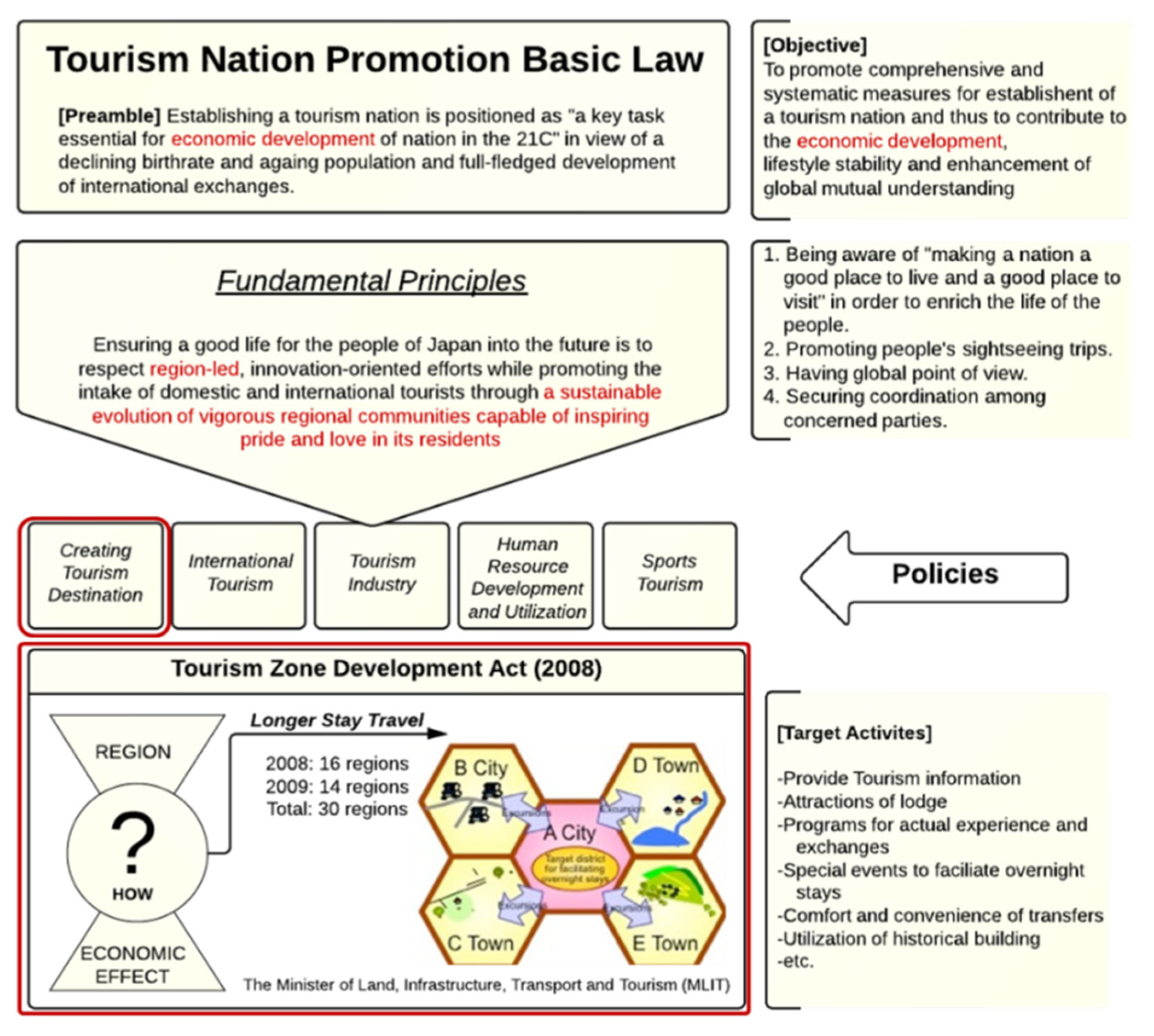
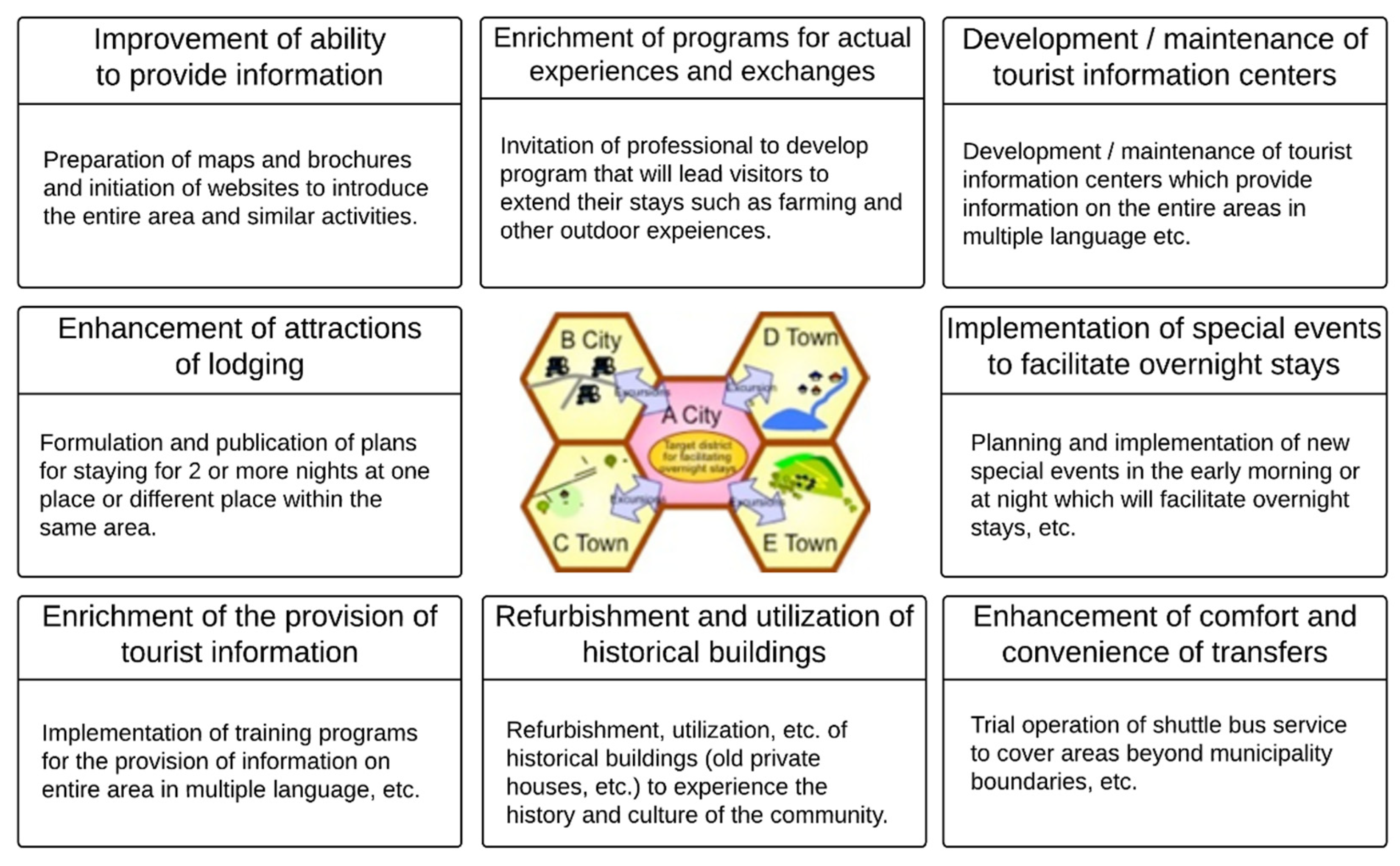
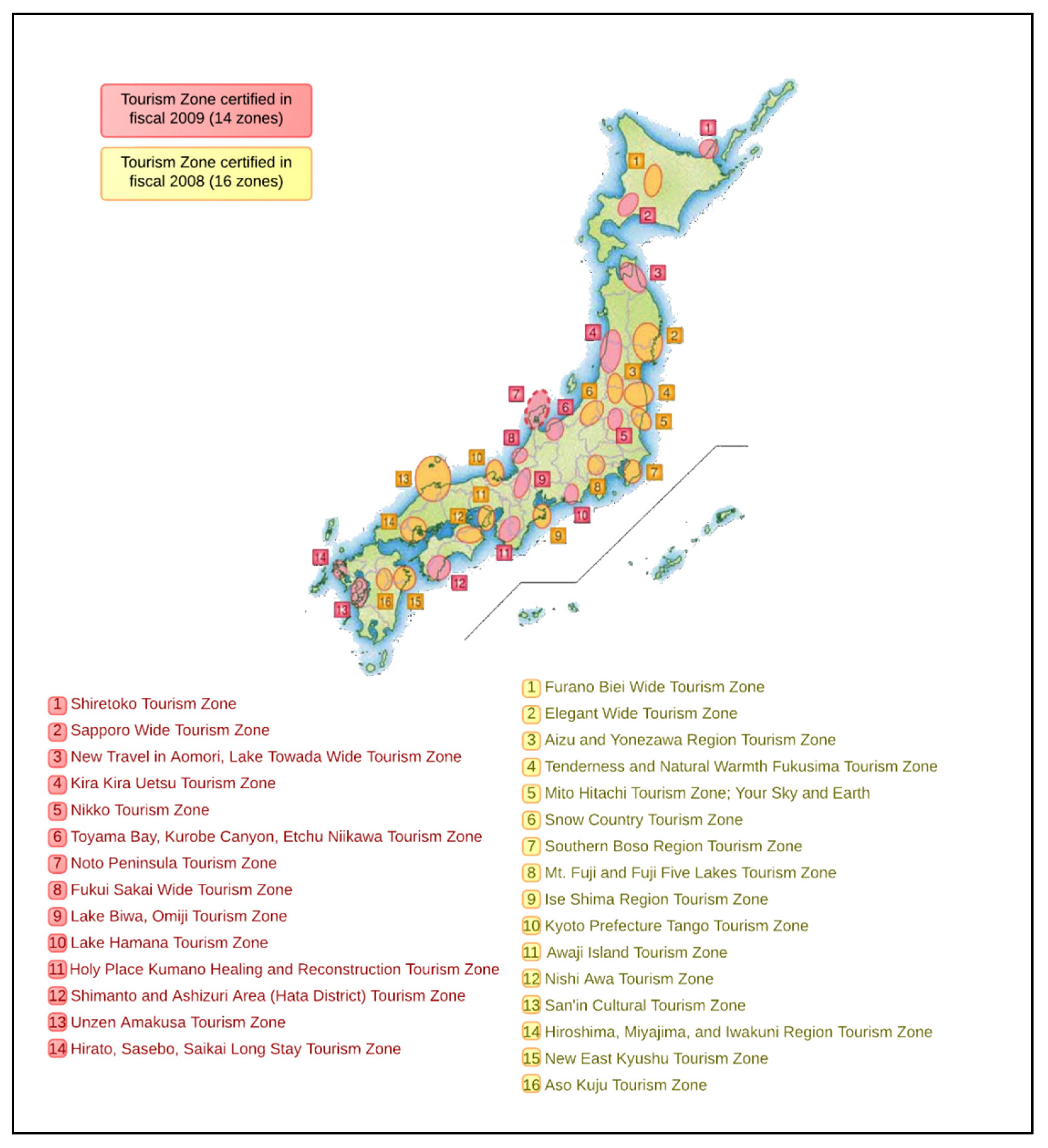
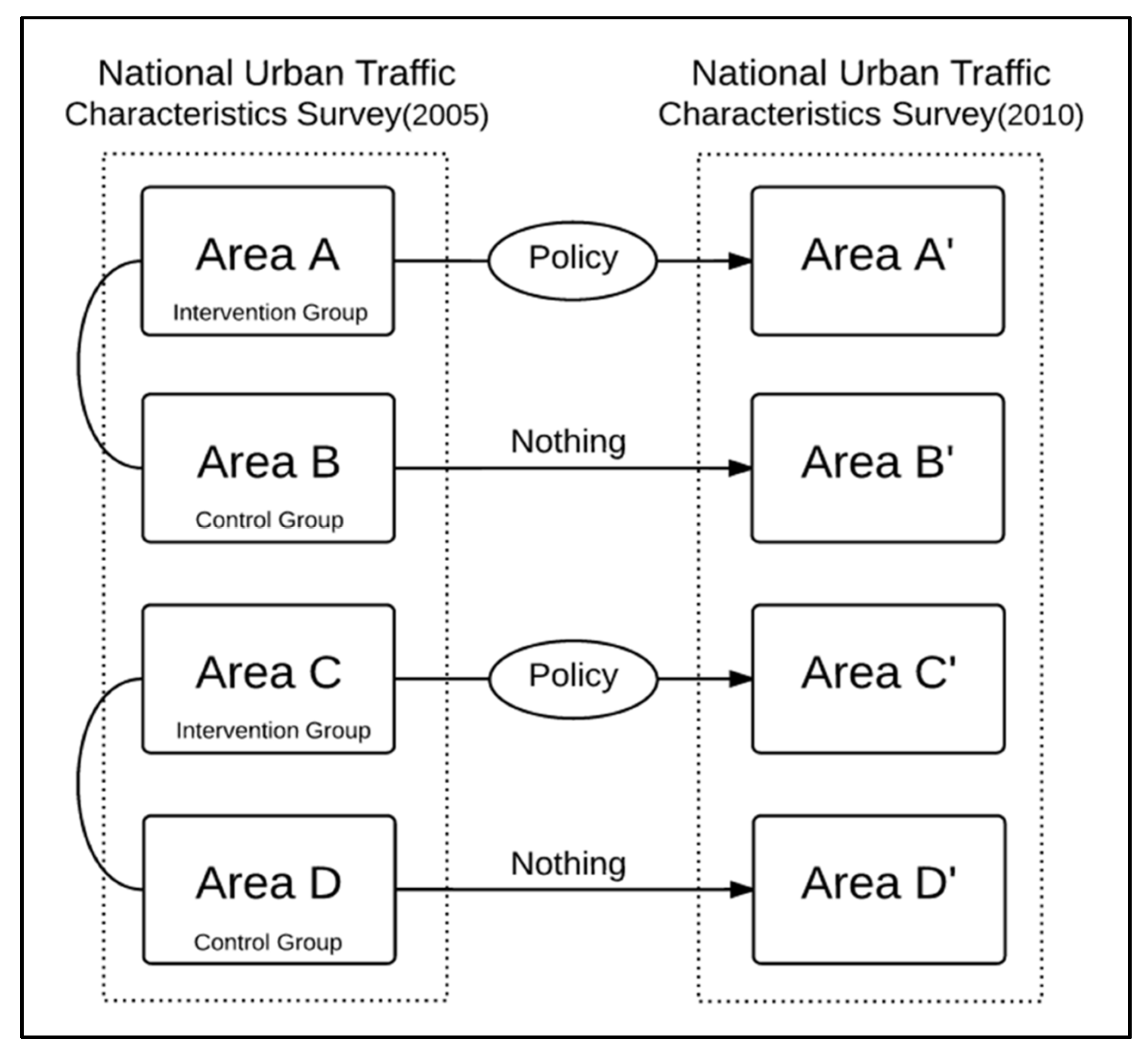
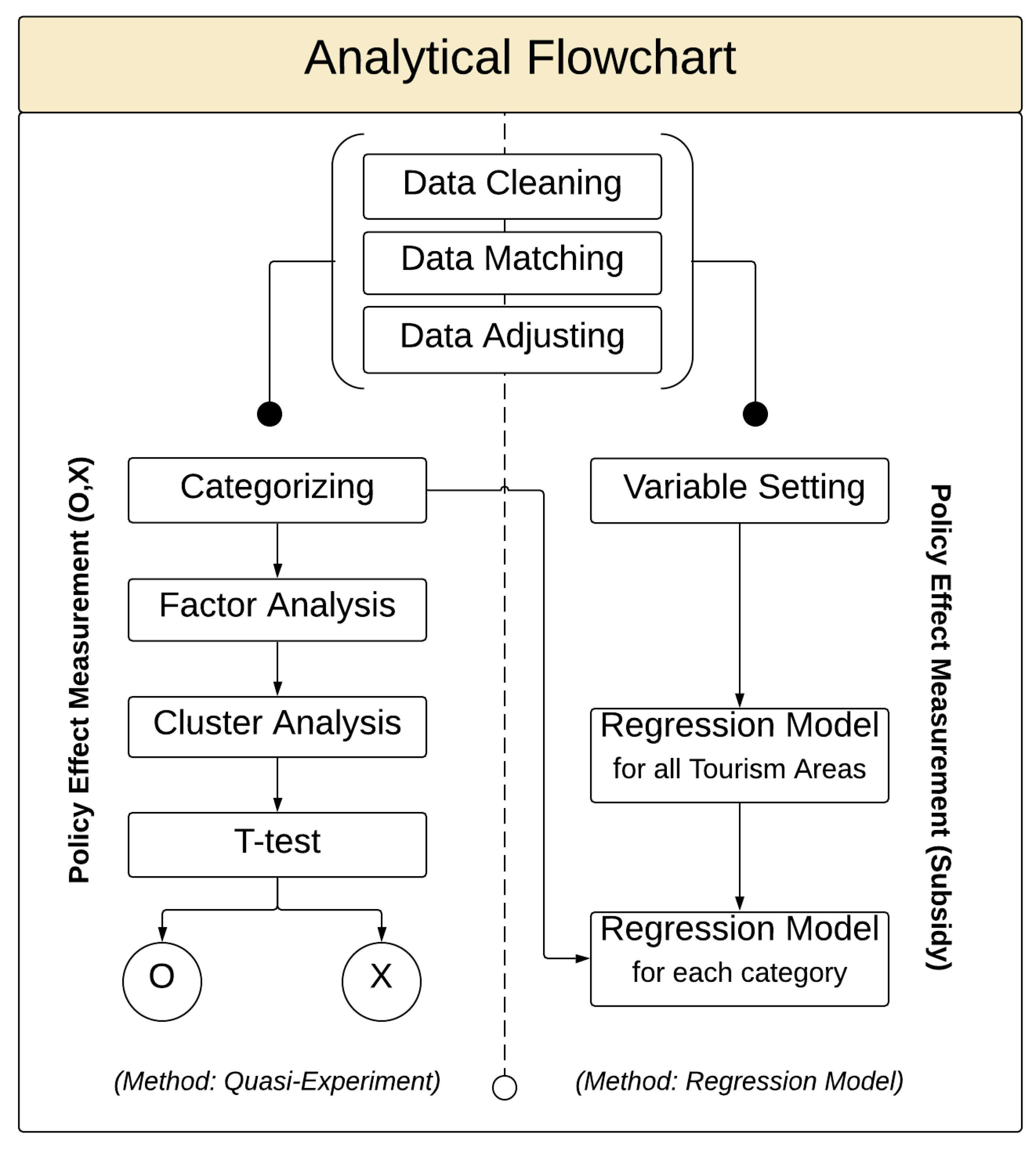
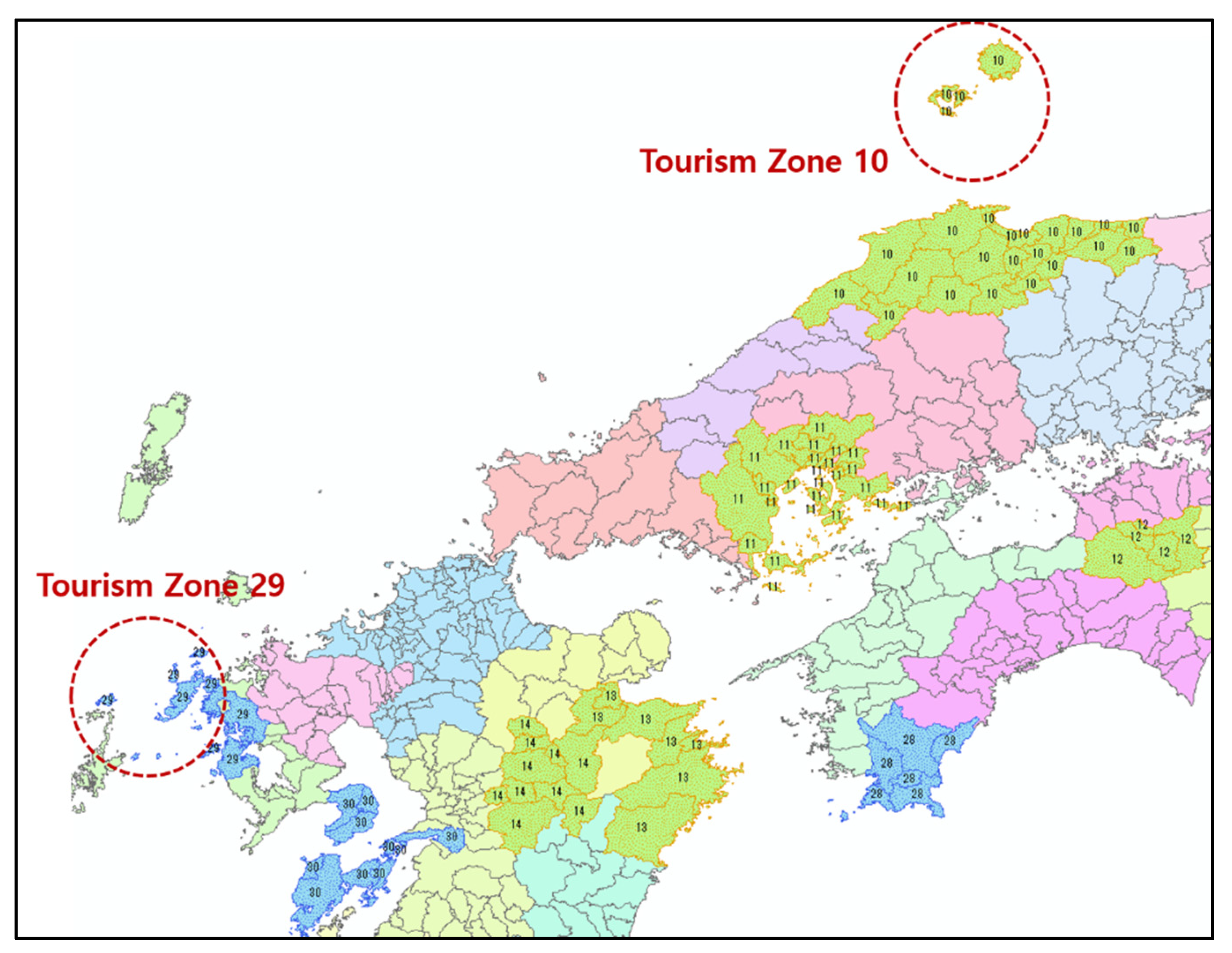
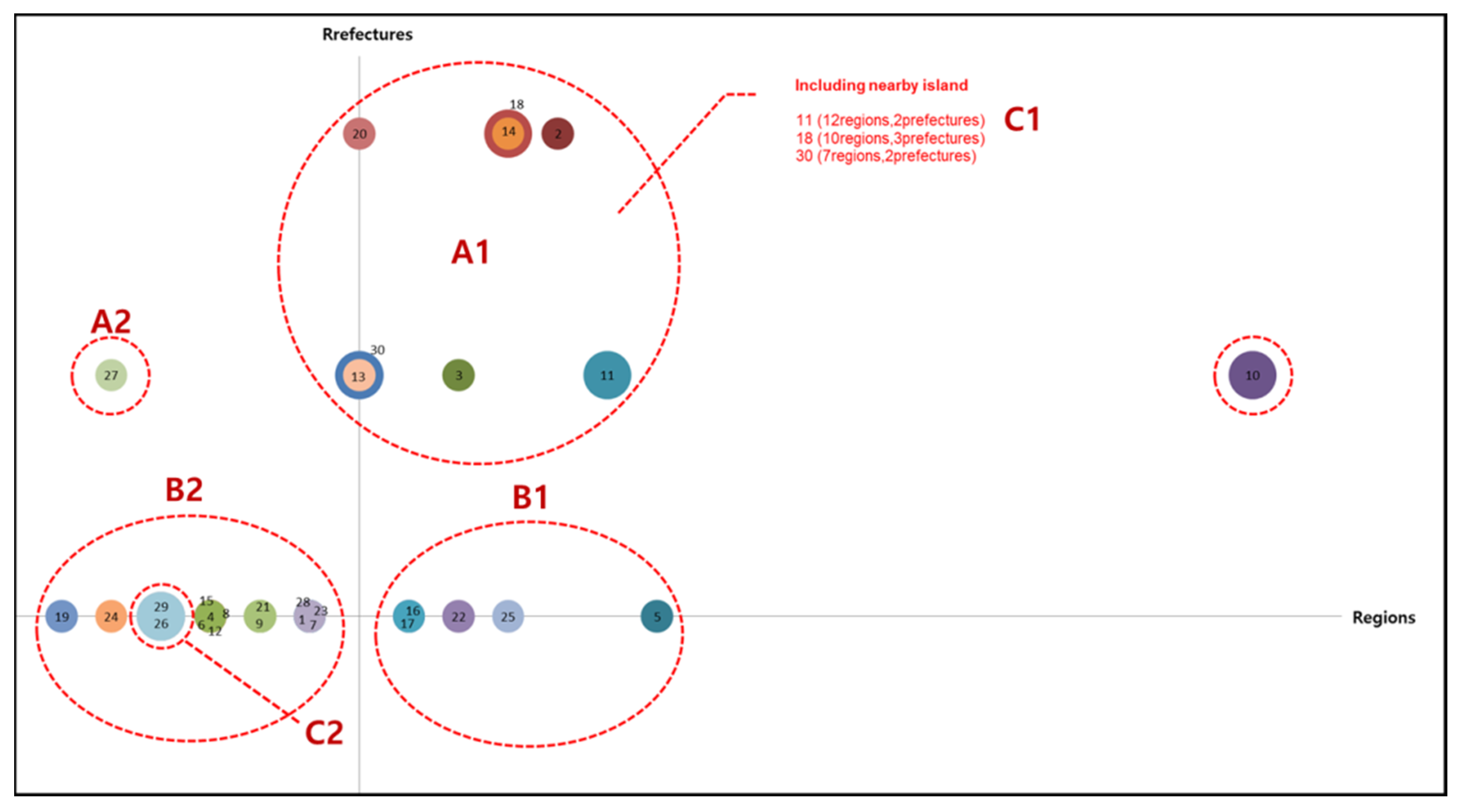
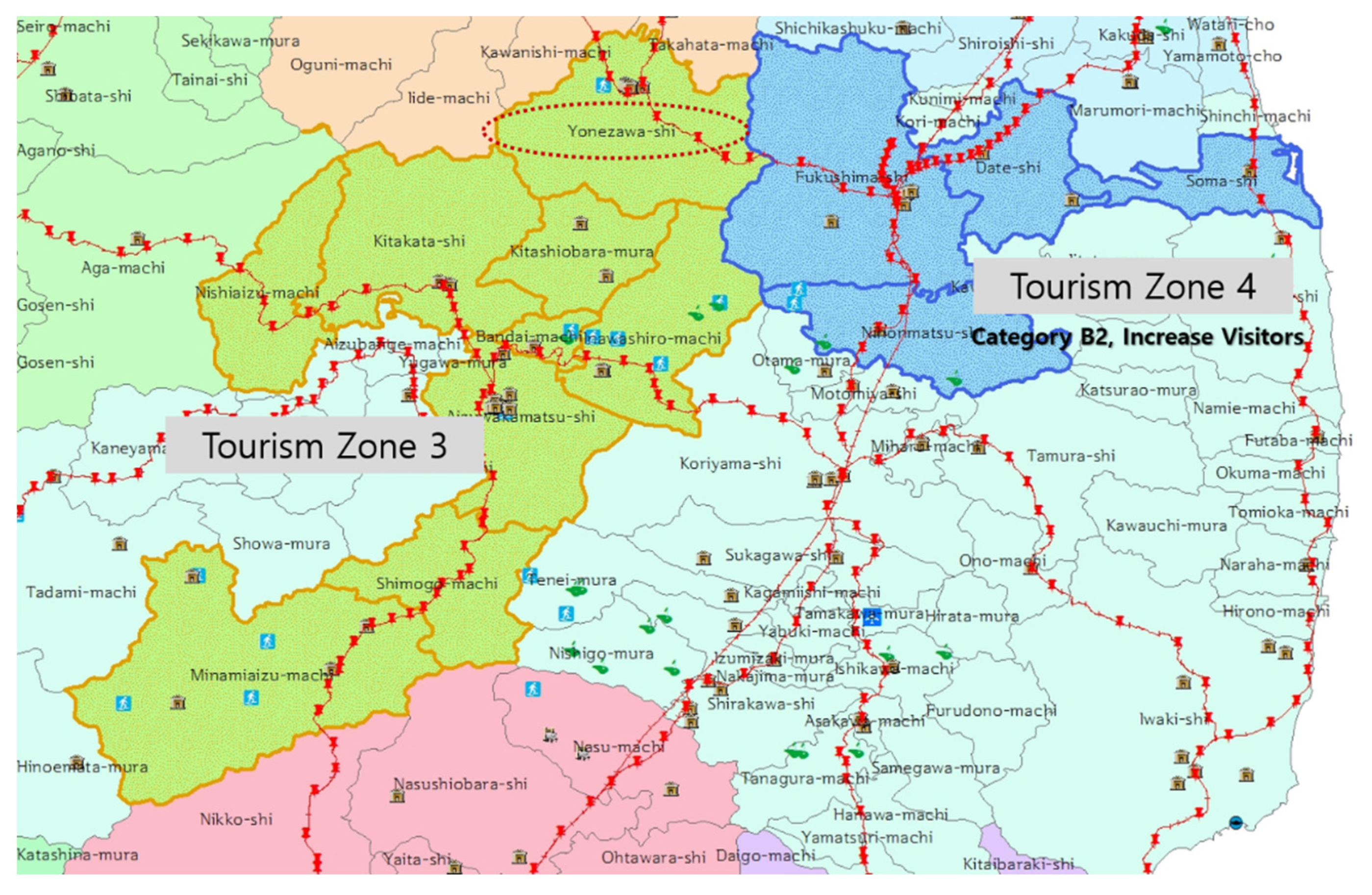
| Quasi-Experimental Designs | Schema |
|---|---|
| Non-equivalent (Pretest and Posttest) Control Group Design | Group A O---------X---------O Group B O--------------------O |
| Single-Group Interrupted Times-Series Design | Group A O--O--O--O--X--O--O--O--O |
| Control Group Interrupted Time-Series Design | Group A O--O--O--O--X--O--O--O—O Group B O--O--O--O--O--O--O--O--O |
| Num | Tourism Zone Name | Municipalities (City/Town) | Prefectures | Island (Dummy) |
|---|---|---|---|---|
| 1 | Furano Biei Wide Tourism Zone | 6 | 1 | 0 |
| 2 | Elegant Wide Tourism Zone | 11 | 3 | 0 |
| 3 | Aizu and Yonezawa Region Tourism Zone | 9 | 2 | 0 |
| 4 | Tenderness and Natural Warmth | 4 | 1 | 0 |
| 5 | Fukusima Tourism Zone | 13 | 1 | 0 |
| 6 | Mito Hitachi Tourism Zone; Your Sky and Earth | 4 | 1 | 0 |
| 7 | Southern Boso Region Tourism Zone | 6 | 1 | 0 |
| 8 | Mt. Fuji and Fuji Five Lakes Tourism Zone | 4 | 1 | 0 |
| 9 | Ise Shima Region Tourism Zone | 5 | 1 | 0 |
| 10 | Kyoto Prefecture Tango Tourism Zone | 25 | 2 | 1 |
| 11 | Sanin Cultural Tourism Zone | 12 | 2 | 1 |
| 12 | Hiroshima, Miyajima, | 4 | 1 | 0 |
| 13 | and Iwakuni Region Tourism Zone | 7 | 2 | 0 |
| 14 | Nishi Awa Tourism Zone | 10 | 3 | 0 |
| 15 | New East Kyushu Tourism Zone | 4 | 1 | 0 |
| 16 | Aso Kuju Tourism Zone | 8 | 1 | 0 |
| 17 | Shiretoko Tourism Zone | 8 | 1 | 0 |
| 18 | Sapporo Wide Tourism Zone | 10 | 3 | 1 |
| 19 | New Travel in Aomori, | 1 | 1 | 0 |
| 20 | Lake Towada Wide Tourism Zone | 7 | 3 | 0 |
| 21 | Kira Kira Uetsu Tourism Zone | 5 | 1 | 0 |
| 22 | Nikko Tourism Zone | 9 | 1 | 0 |
| 23 | Snow Country Tourism Zone | 6 | 1 | 0 |
| 24 | Toyama Bay, Kurobe Canyon, | 2 | 1 | 0 |
| 25 | Etchu Niikawa Tourism Zone | 10 | 1 | 0 |
| 26 | Noto Peninsula Tourism Zone | 3 | 1 | 1 |
| 27 | Fukui Sakai Wide Tourism Zone | 2 | 2 | 0 |
| 28 | Lake Hamana Tourism Zone | 6 | 1 | 0 |
| 29 | Lake Biwa, Omiji Tourism Zone | 3 | 1 | 1 |
| 30 | Awaji Island Tourism Zone | 7 | 2 | 1 |
| Category | Tourism Zone Characteristics | Examples |
|---|---|---|
| A1 | Consists of two or more prefectures. Covers a wide region (seven or more municipalities). | Tourism zone 2, 3, 13, 14, 20 |
| A2 | Consists of two or more prefectures. Covers a narrow region (less than seven municipalities). | Tourism zone 27 |
| B1 | Covers a wide region within the same prefecture. | Tourism zone 5, 16, 17, 22, 25 |
| B2 | Covers a narrow region within the same prefecture. | Tourism zone 1, 4, 6, 7, 8, 9, 12, 15, 19, 21, 23, 24, 28 |
| C1 | Includes a nearby island and consists of two or more prefectures. Covers a wide region (seven or more municipalities). | Tourism zone 10, 11, 18, 30 |
| C2 | Includes a nearby island and Covers a narrow region within the same prefecture (less than seven municipalities). | Tourism zone 26, 29 |
| Kaiser–Meyer–Olkin Measure of Sampling Adequacy. | 0.904 | |
|---|---|---|
| Bartlett’s Test of Sphericity | Approx. Chi-Square | 147,477.977 |
| df | 406 | |
| Sig. | 0.000 | |
| Component | Extraction Sums of Squared Loadings | Rotation Sums of Squared Loadings | ||
|---|---|---|---|---|
| Cumulative% | Total | % of Variance | Cumulative% | |
| 1 | 62.043 | 17.394 | 59.979 | 59.979 |
| 2 | 70.774 | 2.558 | 8.819 | 68.798 |
| 3 | 76.836 | 1.947 | 6.715 | 75.513 |
| 4 | 80.756 | 1.377 | 4.750 | 80.263 |
| 5 | 84.251 | 1.156 | 3.987 | 84.251 |
| … | … | … | … | … |
| Variables | Component | ||||
|---|---|---|---|---|---|
| 1 | 2 | 3 | 4 | 5 | |
| Total households | 0.993 | 0.048 | 0.043 | 0.016 | 0.007 |
| Persons employed in the tertiary industry (person) | 0.989 | 0.066 | 0.055 | 0.026 | 0.005 |
| Population 15 to 64 years old (person) | 0.989 | 0.076 | 0.064 | 0.044 | 0.009 |
| Total population (person) | 0.988 | 0.088 | 0.061 | 0.052 | 0.012 |
| Labor force (person) | 0.988 | 0.094 | 0.063 | 0.054 | 0.008 |
| Immigrants from other prefectures (person) | 0.987 | −0.008 | 0.037 | −0.019 | −0.006 |
| Daytime population (person) | 0.986 | 0.055 | 0.044 | −0.002 | −0.003 |
| Total welfare expenditure (thousand yen) | 0.985 | 0.029 | 0.007 | 0.043 | 0.025 |
| Taxable income (thousand yen) | 0.981 | 0.025 | 0.064 | −0.050 | −0.022 |
| Total dwellings | 0.963 | −0.100 | 0.061 | −0.017 | 0.008 |
| Commercial and neighboring commercial area (ha) | 0.959 | 0.104 | 0.018 | 0.122 | 0.019 |
| Persons employed in the secondary industry (person) | 0.953 | 0.160 | 0.106 | 0.142 | 0.003 |
| Manufacturing establishments | 0.930 | 0.083 | 0.042 | 0.067 | 0.011 |
| Local taxes (thousand yen) | 0.928 | 0.090 | 0.085 | 0.241 | 0.005 |
| DIDs area (km2) | 0.926 | −0.015 | 0.117 | 0.189 | 0.026 |
| Public works expenditure (thousand yen) | 0.883 | 0.116 | 0.025 | 0.315 | 0.035 |
| Industrial and quasi-industrial area (ha) | 0.861 | 0.214 | 0.083 | 0.277 | 0.042 |
| Persons at work in manufacturing establishments (person) | 0.829 | 0.240 | 0.164 | 0.255 | −0.009 |
| Commerce and manufacturing expenditure (thousand yen) | 0.673 | 0.090 | −0.066 | 0.435 | 0.055 |
| Labor expenditure (thousand yen) | 0.666 | 0.227 | 0.130 | −0.009 | 0.082 |
| Persons employed in the primary industry (person) | 0.200 | 0.872 | −0.048 | 0.091 | 0.026 |
| Agriculture forestry and fishery expenditure (thousand yen) | 0.157 | 0.852 | −0.143 | 0.144 | 0.012 |
| Cultivated land area (ha) | 0.000 | 0.816 | −0.074 | −0.045 | −0.096 |
| Financial strength index | 0.013 | −0.099 | 0.751 | 0.329 | −0.059 |
| Taxable income per tax debtor (thousand yen) | 0.238 | −0.080 | 0.703 | −0.052 | −0.269 |
| Ratio of owned houses | 0.044 | −0.167 | 0.674 | 0.031 | 0.191 |
| Public halls per 1,000,000 persons | −0.050 | −0.238 | −0.510 | 0.216 | −0.473 |
| Exclusive industrial area (ha) | 0.217 | 0.138 | 0.160 | 0.776 | 0.037 |
| Unemployment rate | 0.053 | −0.124 | −0.042 | 0.089 | 0.891 |
| Group | Mean | Std. Deviation | t-Value | Sig. |
|---|---|---|---|---|
| Control Group1 | 0.7143 | 1.20439 | −2.233 | 0.044 ** |
| Tourism Zone 1 | 2.0714 | 2.26900 | ||
| Control Group 3 | −0.0714 | 1.60851 | −1.842 | 0.077 * |
| Tourism Zone 3 | 0.0000 | 2.50924 | ||
| Control Group 4 | 1.1154 | 4.79439 | −1.758 | 0.091 * |
| Tourism Zone 4 | 2.3462 | 5.80994 | ||
| Control Group 7 | −0.1667 | 2.47890 | −3.669 | 0.001 *** |
| Tourism Zone 7 | 2.0417 | 2.47561 | ||
| Control Group 8 | 0.4138 | 1.11858 | −4.332 | 0.000 *** |
| Tourism Zone 8 | 2.6207 | 2.65133 | ||
| Control Group 12 | 1.3889 | 2.27877 | −2.887 | 0.010 *** |
| Tourism Zone 12 | 3.0556 | 2.85888 | ||
| Control Group 15 | 0.2857 | 0.95119 | −3.873 | 0.008 *** |
| Tourism Zone 15 | 1.7143 | 0.48795 | ||
| Control Group 19 | 0.1579 | 1.64192 | −6.470 | 0.000 *** |
| Tourism Zone 19 | 3.7368 | 2.18180 |
| Group | Mean | Std. Deviation | t-Value | Sig. |
|---|---|---|---|---|
| Control Group 5 | 0.9714 | 1.88626 | −1.128 | 0.267 |
| Tourism Zone 5 | 1.4571 | 1.97548 | ||
| Control Group 6 | 0.6667 | 1.21106 | −0.896 | 0.411 |
| Tourism Zone 6 | 3.0000 | 6.06630 | ||
| Control Group 20 | 1.1613 | 2.60892 | −0.299 | .0767 |
| Tourism Zone 20 | 1.3548 | 2.07442 | ||
| Tourism Zone 23 | 0.9655 | 2.94573 | −1.438 | 0.161 |
| Control Group 23 | 2.3448 | 3.91221 | ||
| Control Group 24 | 1.6875 | 2.27211 | −0.92 | 0.928 |
| Tourism Zone 24 | 1.7500 | 0.85635 | ||
| Control Group 27 | 0.8710 | 1.89283 | −0.867 | 0.393 |
| Tourism Zone 27 | 1.1613 | 1.00322 | ||
| Control Group 28 | 1.6875 | 2.27211 | −1.165 | 0.262 |
| Tourism Zone 28 | 2.2500 | 1.80739 | ||
| Control Group 30 | 0.5238 | 2.42114 | −0.249 | 0.806 |
| Tourism Zone 30 | 0.7143 | 3.88771 |
| Group | Mean | Std. Deviation | t-Value | Sig. |
|---|---|---|---|---|
| Control Group 11 | 2.2143 | 8.50393 | 0.50 | 0.960 |
| Tourism Zone 11 | 2.1607 | 8.93568 | ||
| Control Group 13 | 0.6842 | 2.32618 | 0.612 | 0.545 |
| Tourism Zone 13 | −0.0526 | 6.28575 | ||
| Control Group 18 | 0.7059 | 3.72159 | 0.227 | 0.822 |
| Tourism Zone 18 | 0.5588 | 1.58001 | ||
| Control Group 21 | 6.7778 | 18.93579 | 0.458 | 0.650 |
| Tourism Zone 21 | 5.2963 | 12.47093 | ||
| Control Group 26 | 0.4211 | 1.57465 | 0.297 | 0.770 |
| Tourism Zone 26 | 0.2632 | 1.75885 | ||
| Control Group 29 | 2.1875 | 1.64190 | 0.889 | 0.388 |
| Tourism Zone 29 | 1.6875 | 1.07819 |
| Project | Project Details |
|---|---|
| Project 1 | Improving stay program, marketing, development of human resource/awareness enlightenment |
| Project 2 | Information transmission, measures for the secondary traffic, space formation |
| Project 3 | Inbound support, quality management |
| Dependent Variable | Arrivals Change for Tour (∆2010–2005) | Source [36] | |
|---|---|---|---|
| Explanatory Variables | Vitality | Daytime population (person) | Source [37] |
| Rate of day to night population (%) | |||
| Commerce | Commerce and manufacturing expenditure (thousand yen) | ||
| Persons employed in the tertiary industry (person) | |||
| Commercial and neighboring commercial area (ha) | |||
| Attractions | Number of public parks | ||
| Number of zoos | |||
| Number of art museums | |||
| Number of golf clubs | |||
| Transportation | Total real length of roads (km) | Source [45] | |
| Total real length of major roads (km) | |||
| Total real length of local roads (km) | |||
| Total real length of major paved roads (km) | |||
| Total real length of local paved roads (km) | |||
| Tourism Zone Development Policy | Dummy_project1 | Source: JTA | |
| Dummy_project2 | |||
| Dummy_project3 | |||
| Project 1 subsidy(yen) | |||
| Project 2 subsidy(yen) | |||
| Project 3 subsidy(yen) | |||
| Total project subsidy (Total yen) | |||
| Number of cities/towns |
| Independent Variables | Beta | t-Value | Sig. | Tolerance | VIF |
|---|---|---|---|---|---|
| (Constant) | 3.316 | 0.001 *** | |||
| Commerce and manufacturing expenditure | 0.476 | 8.097 | 0.000 *** | 0.967 | 1.035 |
| Number of public parks | 0.382 | 6.317 | 0.000 *** | 0.916 | 1.092 |
| Project 1 subsidy | −0.102 | −1.671 | 0.097 * | 0.898 | 1.113 |
| Project 2 subsidy | −0.019 | −0.322 | 0.748 | 0.965 | 1.037 |
| Project 3 subsidy | 0.007 | 0.121 | 0.904 | 0.926 | 1.08 |
| Independent Variables | Beta | t-Value | Sig. | Tolerance | VIF |
|---|---|---|---|---|---|
| (Constant) | −3.313 | 0.002 *** | |||
| Commerce and manufacturing expenditure (thousand yen) | 0.635 | 10.066 | 0.000 *** | 0.969 | 1.032 |
| Number of public parks | 0.427 | 6.606 | 0.000 *** | 0.922 | 1.084 |
| Project 1 subsidy | 0.307 | 3.579 | 0.001 *** | 0.522 | 1.914 |
| Project 2 subsidy | 0.185 | 2.729 | 0.008 *** | 0.843 | 1.186 |
| Project 3 subsidy | 0.267 | 3.329 | 0.002 *** | 0.601 | 1.664 |
| Independent Variables | Beta | t-Value | Sig. | Tolerance | VIF |
|---|---|---|---|---|---|
| (Constant) | 3.001 | 0.004 *** | |||
| Commerce and manufacturing expenditure (thousand yen) | 0.706 | 7.619 | 0.000 *** | 0.919 | 1.088 |
| Number of public parks | 0.417 | 4.380 | 0.000 *** | 0.873 | 1.146 |
| Project 1 subsidy | −0.254 | −2.678 | 0.010 *** | 0.879 | 1.138 |
| Project 2 subsidy | −0.077 | −0.787 | 0.435 | 0.820 | 1.220 |
| Project 3 subsidy | −0.015 | −0.151 | 0.880 | 0.858 | 1.166 |
| Independent Variables | Beta | t-Value | Sig. | Tolerance | VIF |
|---|---|---|---|---|---|
| (Constant) | 1.252 | 0.22 | |||
| Number of public parks | 0.451 | 3.012 | 0.005 *** | 0.94 | 1.064 |
| Project 1 subsidy | −0.419 | −2.459 | 0.019 ** | 0.725 | 1.38 |
| Project 2 subsidy | 0.104 | 0.618 | 0.541 | 0.736 | 1.359 |
| Project 3 subsidy | −0.026 | −0.168 | 0.867 | 0.913 | 1.096 |
| Independent Variables | Beta | t-Value | Sig. | Tolerance | VIF |
|---|---|---|---|---|---|
| (Constant) | 3.653 | 0 | |||
| Commerce and manufacturing expenditure | 0.679 | 9.282 | 0.000 *** | 0.92 | 1.087 |
| Dummy_project1 | −0.273 | −2.582 | 0.011 ** | 0.439 | 2.275 |
| Project 1 subsidy | 0.077 | 0.758 | 0.451 | 0.472 | 2.119 |
| Project 2 subsidy | 0.162 | 1.954 | 0.054 * | 0.718 | 1.392 |
| Project 3 subsidy | 0.138 | 1.62 | 0.108 | 0.683 | 1.465 |
| Independent Variables | Beta | t-Value | Sig. | Tolerance | VIF |
|---|---|---|---|---|---|
| (Constant) | 0.251 | 0.803 | |||
| Daytime population (person) | 0.759 | 6.023 | 0.000 *** | 0.704 | 1.42 |
| Number of public parks | 0.512 | 4.228 | 0.000 *** | 0.761 | 1.313 |
| Project 1 subsidy | 0.065 | 0.191 | 0.85 | 0.096 | 10.433 |
| Project 2 subsidy | 0.035 | 0.101 | 0.92 | 0.09 | 11.054 |
| Project 3 subsidy | 0.1 | 0.872 | 0.388 | 0.852 | 1.174 |
| All Areas | Category A | Category B | Category C | Most Effective | Least Effective | |
|---|---|---|---|---|---|---|
| Project 1 Subsidy | - | - | + | - | ||
| Project 2 Subsidy | + | + | ||||
| Project 3 Subsidy | + |
| Tourism Zone | Increase Visitors (Quasi-Experiment) | Most Effective Case (Regression Model) | Category |
|---|---|---|---|
| 1 | ○ | ○ | B2 |
| 3 | ○ | ○ | A1 |
| 4 | ○ | B2 | |
| 5 | ○ | B1 | |
| 7 | ○ | ○ | B2 |
| 8 | ○ | B2 | |
| 9 | ○ | B2 | |
| 11 | ○ | C1 | |
| 12 | ○ | ○ | B2 |
| 14 | ○ | A1 | |
| 15 | ○ | ○ | B2 |
| 19 | ○ | B2 | |
| 24 | ○ | B2 | |
| 25 | ○ | B1 |
Publisher’s Note: MDPI stays neutral with regard to jurisdictional claims in published maps and institutional affiliations. |
© 2021 by the authors. Licensee MDPI, Basel, Switzerland. This article is an open access article distributed under the terms and conditions of the Creative Commons Attribution (CC BY) license (https://creativecommons.org/licenses/by/4.0/).
Share and Cite
Kim, H.; Kim, E.J. Tourism as a Key for Regional Revitalization?: A Quantitative Evaluation of Tourism Zone Development in Japan. Sustainability 2021, 13, 7478. https://doi.org/10.3390/su13137478
Kim H, Kim EJ. Tourism as a Key for Regional Revitalization?: A Quantitative Evaluation of Tourism Zone Development in Japan. Sustainability. 2021; 13(13):7478. https://doi.org/10.3390/su13137478
Chicago/Turabian StyleKim, Hyunjung, and Eun Jung Kim. 2021. "Tourism as a Key for Regional Revitalization?: A Quantitative Evaluation of Tourism Zone Development in Japan" Sustainability 13, no. 13: 7478. https://doi.org/10.3390/su13137478
APA StyleKim, H., & Kim, E. J. (2021). Tourism as a Key for Regional Revitalization?: A Quantitative Evaluation of Tourism Zone Development in Japan. Sustainability, 13(13), 7478. https://doi.org/10.3390/su13137478







